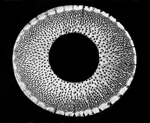
「修行尺八」歴史的証拠の研究 ホームページ
'Shugyō Shakuhachi' rekishi-teki shōko no kenkyū hōmupēji - zen-shakuhachi.dk
The "Ascetic Shakuhachi" Historical Evidence Research Web Pages
Introduction & Guide to the Documentation & Critical Study of Ascetic, Non-Dualistic Shakuhachi Culture, East & West:
Historical Chronology, Philology, Etymology, Vocabulary, Terminology, Concepts, Ideology, Iconology & Practices
By Torsten Mukuteki Olafsson •
トーステン
無穴笛
オーラフソン •
デンマーク • Denmark
|
Historical Shakuhachi Images Part 1 - till about 1640:Historical Shakuhachi Images 2 - from just before 1640 till the Present: A Pictorial Chronology of Known Fine Historical Illustrations of so called 'Shakuhachi' Flutes, Its Many Players Throughout The Times, with Additional Shakuhachi History Related Images INDIA a. 2600 BCE: 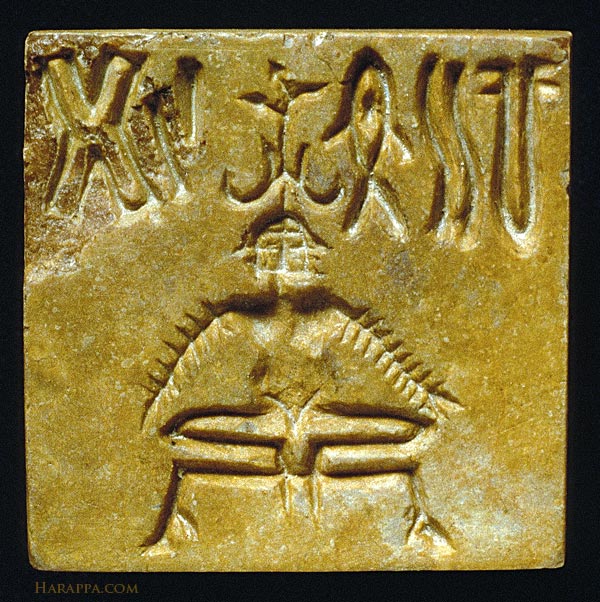
Square seal depicting a nude male deity with three faces, seated in yogic position on a throne. Harappan Bronze Age Culture, c. 2600-1900 BCE. Dimensions: 2.65 x 2.7 cm, 0.83 to 0.86 cm thickness. Excavated at Mohenjo-daro, present-day Punjab, Pakistan. Now in the Islamabad Museum. Sources: https://www.pinterest.dk/pin/289285976042826155/ https://www.harappa.com/indus/33.html CHINA 6000 BCE or even older? - THE OLDEST PLAYABLE FLUTES in the WORLD 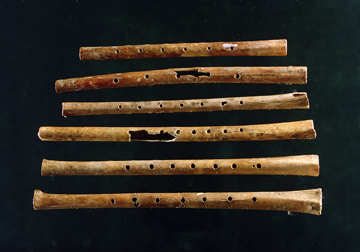 Ancient bone flutes excavated at Jiahu, Henan Province, Central China, in 1986. The Jiahu site was inhabited between a. 7.000 BCE to a. 5.700 BCE. Read more about these remarkable old musical instruments here: Brookhaven National Laboratory: Bone Flute Found in China Shakuhachi.com: Article in Nature Magazine 1999 Wikipedia.org: Gudi (instrument) Icobase: Flutes Aerophones Listen to sound samples here: Brookhaven National Laboratory: Wav file 1 (4.2 MB) Erik the Flute Maker Ca. 180 BCE: 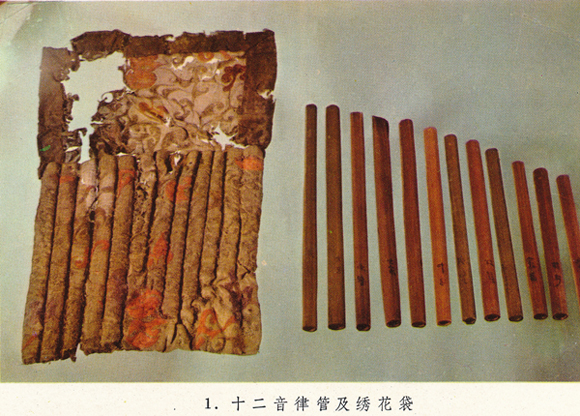
Set of 12 Chinese pitch pipes dated a. 180 BCE found at a famous, very significant burial site at Ma-wang-tui, No. 3 Tomb, near Ch'ang-sha in Hunan Province, China. Picture from a special edition of the archaeological magazine Wen Wu, September, 1972. It has to be noted that the 12 pitch pipes shown were apparently manufactured to be part of a special Chinese Han Period type of mouth organ, namely the 'yu', 竽. Around 630-645: Chinese T'ang Dynasty music master Lü Ts'ai, 呂才, 606-665, creates 12 bamboo pitch pibes and perhaps even also the Chinese 'shakuhachi'? 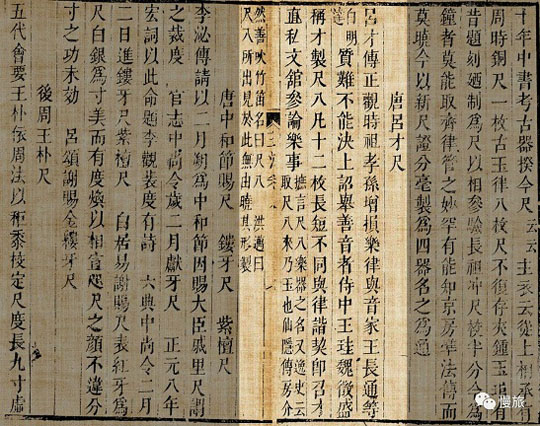
One T'ang-shu edition in the possession of the Museum of Hangzhou Local Chronicles/Hangzhou Local History Museum, China. 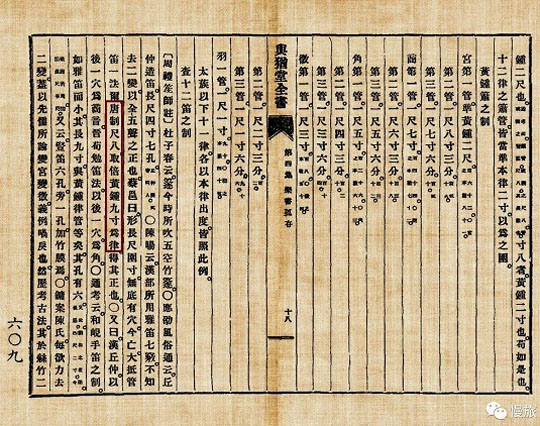
Dimensions of the bamboo pitch pipes 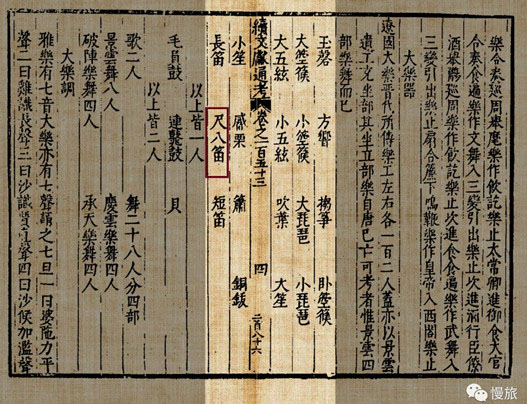
Names of T'ang court musical instruments listed in the T'ang-shu In the far left of the illuminated columns, three flutes are named as follows: 長笛, 'cháng dí'/'chō-teki', "long Flute"; 尺八笛, 'chǐ bā dí'/'shakuhachi teki', "shakuhachi flute"; 短笛, 'duǎn dí'/'tan-teki', "short flute". 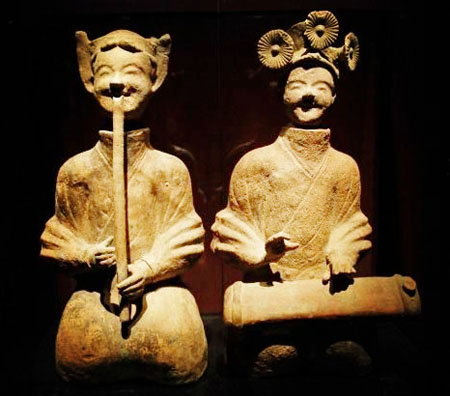
Clay figurines of possibly Chinese T'ang Dynasty musicians, the one to the left seemingly a 'xiao'/Chinese 'shakuhachi' player, the one to the right playing a horizontal stringed zither. Source: https://hznews.hangzhou.com.cn/wghz/content/2019-10/11/content_7282303_0.htm Around 750 CE: 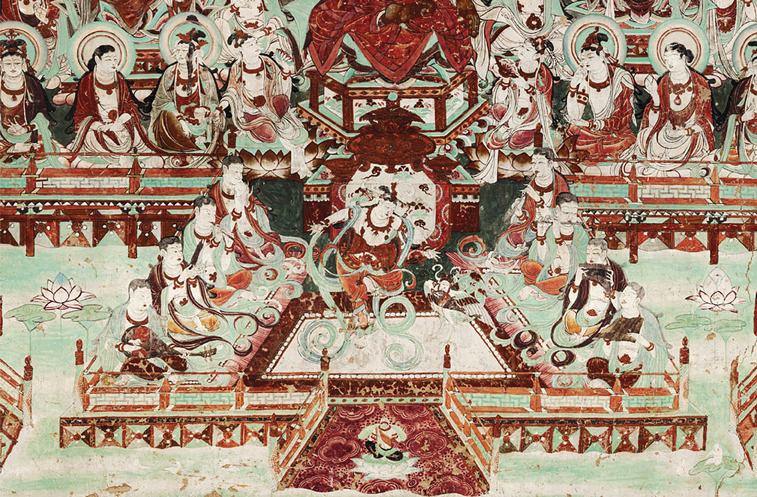
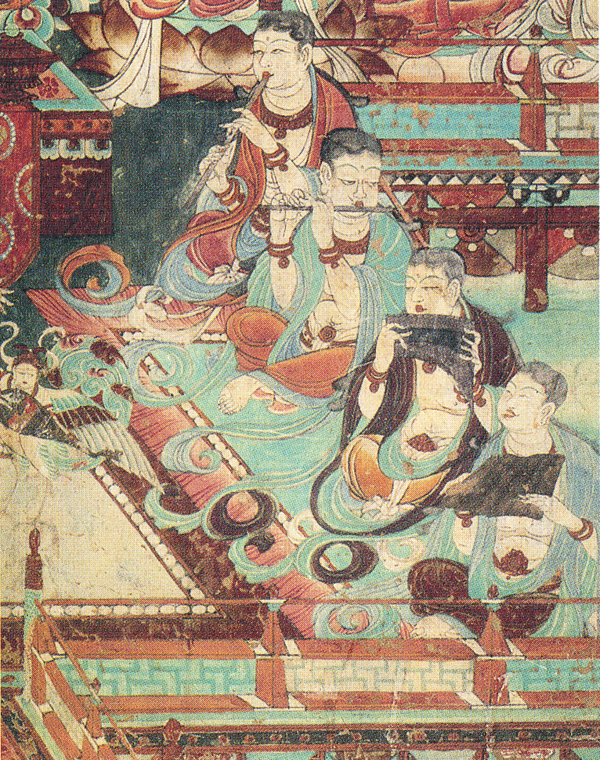
Musicians pictured in a wall painting in Cave 25, 'Yulin', at Tun-huang on the Silk Road, in the Kansu Province, W. China. The Yulin grotto system was built since the N. Wei Dynasty, 356-534 CE. The player at the top appears to be blowing a very long, quite thin flute that quite much resembles the modern Chinese 6-holed 't'ung-hsiao'/'dong-xiao', 洞簫, Jap.: 'dōshō'. Source: Izumi Takeo, 2016, p. 5, and the Internet About 750 CE - Painting dated approx. 970 CE: 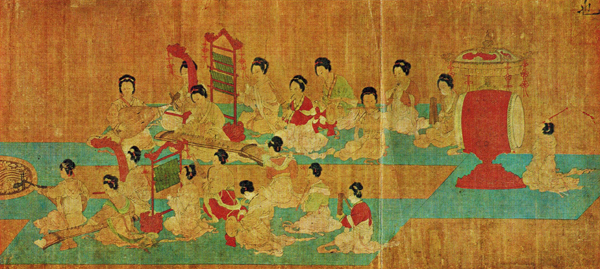
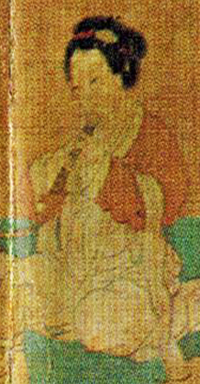
Female Chinese musicians performing in the T'ang Emperor Ming Huang's palace, mid-8th century. In the background to the right we see a musician blowing a medium long vertical flute - maybe a 't'ung-hsiao', 洞簫, Jap.: 'dōshō'. Scroll painting on silk attributed to the Chinese Imperial court painter Chou Wen-chü, ca. 970. Source: Werner Speiser, 1961, p. 176 JAPAN Around 700 CE?: 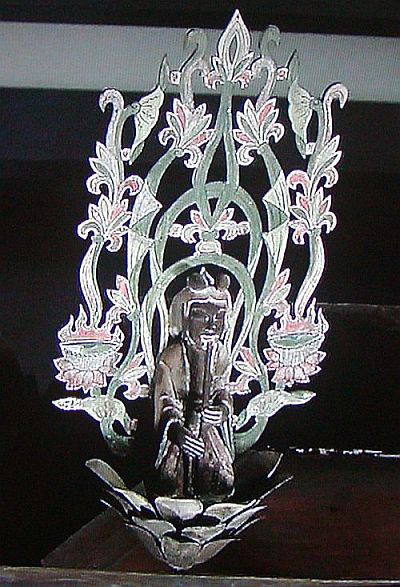
Small sculpture of a bodhisattva playing a shakuhachi look-alike. Discovered in 2009 during a restoration of the canopy overhanging the Shaka Triad being housed in the Hōryū-ji Kondō. Source: Yatō Umiosa's 'Komusō' website 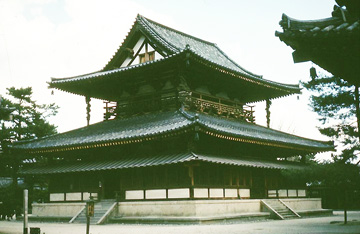 Hōryū-ji Kondō, Nara - Photo: T.O. 1977 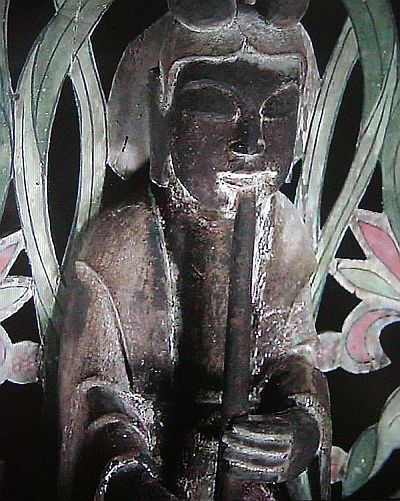
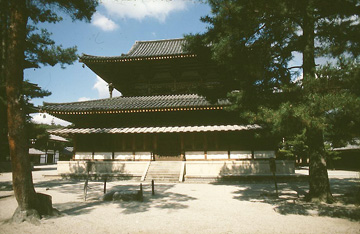
Hōryū-ji Kondō, Nara - Photo: T.O. 1977 Early 8th century - maybe even early 7th century?: 
5+1 hole 'Gagaku' type shakuhachi officially owned by the Hōryū Temple in Nara in The Gallery of Hōryū-ji Treasures, Tokyo National Museum. Precise date unclear. Possibly not later than early 7th century, or so? Photo from the Tumblr gallery "Sally Away From Home". Source: https://sallyawayfromhome.tumblr.com/post/168497873724/tokyo-national-museum-what-a-treasure-house-of 8th CENTURY: 雅楽尺八 - GAGAKU SHAKUHACHI  Shōsōin Imperial Treasury, Tōdai-ji, Nara - early 8th century 
Gagaku Shakuhachi, Shōsōin Imperial Treasury, Tōdai-ji, Nara Early 8th century 8th CENTURY: 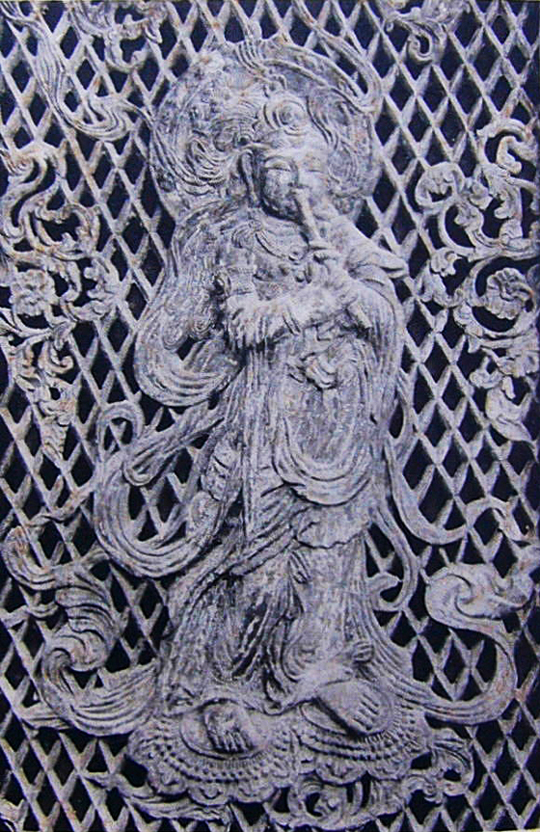
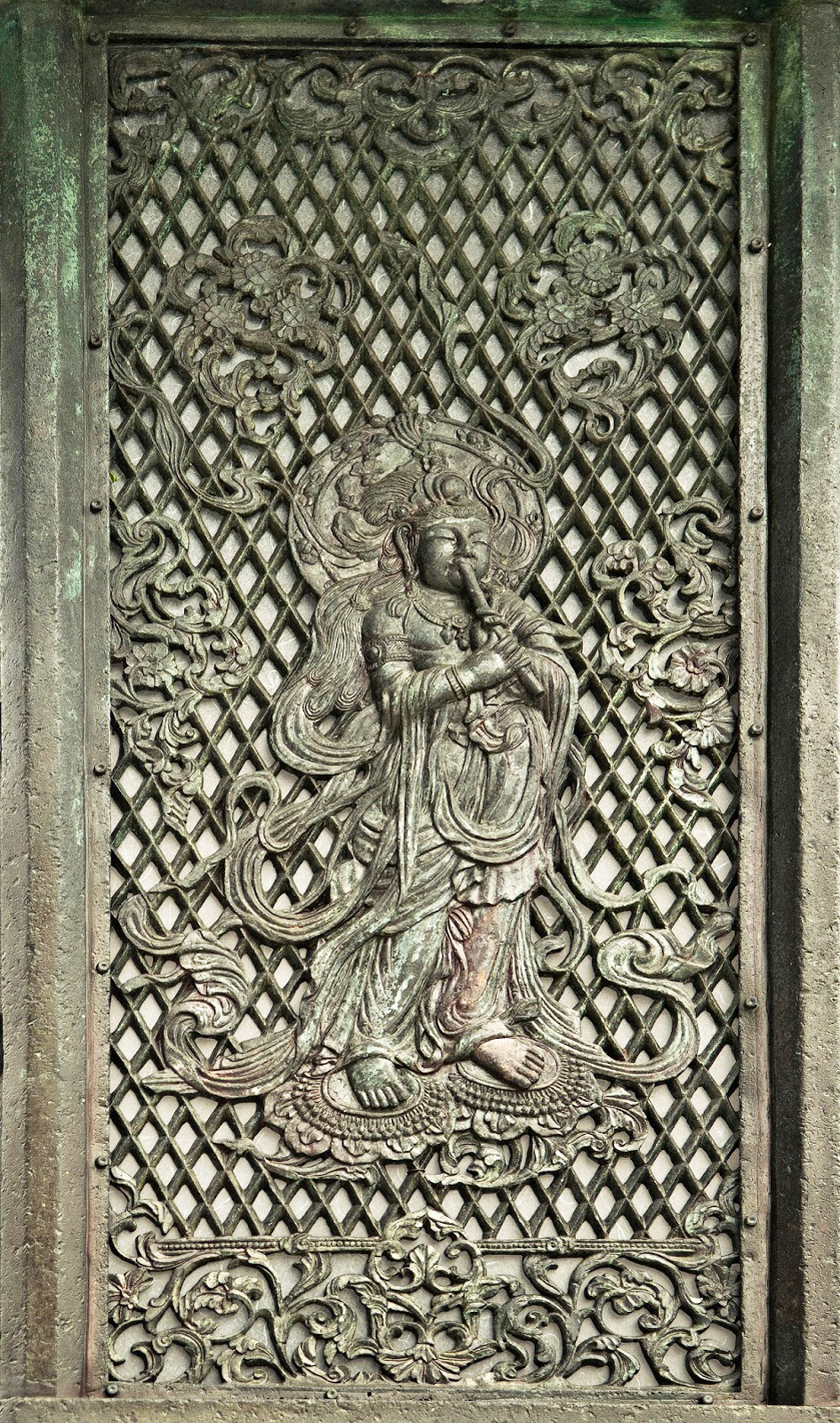
Bodhisattva musician playing the shakuhachi, Tōdai-ji, Nara. Detail of a large bronze lamp standing in front of the Great Buddha Hall. One of the very few remains of the original 8th century temple. Sources: Wikipedia & the Internet 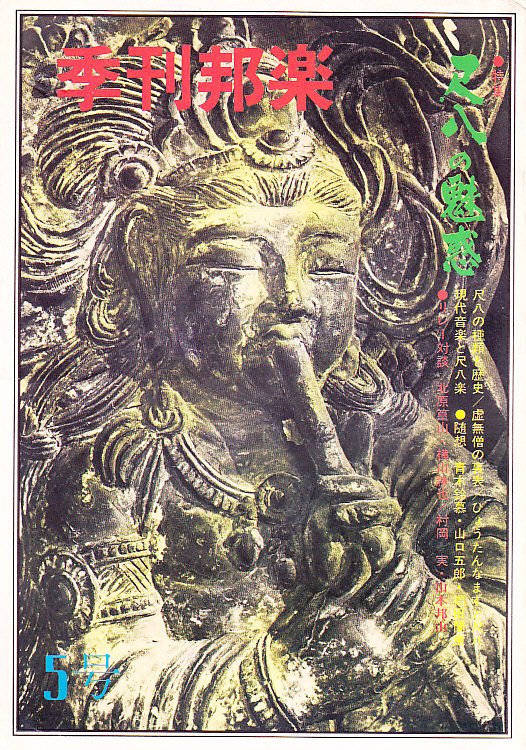
Tōdai-ji bronze lamp shakuhachi player on the front cover of the 'Kikan Hōgaku' journal, 1975 PAINTING of RŌAN PLAYING a LONG VERTICAL FLUTE 朗庵吹笛画 - RŌAN SUITEKI-GA 無常心 - MUJŌ-SHIN Is this really a "genuine work of art"? 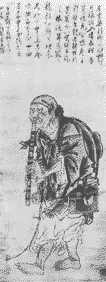
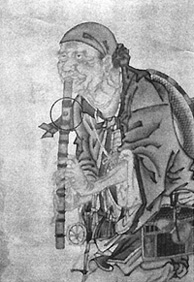
Picture of Rōan Playing a Flute Painting attributed to the Zen monk and painter Shōkei, aka Kei Shoki, "Clerksman Kei", who was active during the last two decades of the 1400s and died in 1518. In the collection of the late Kowata Suigetsu, 木幡吹月, 1901-1983 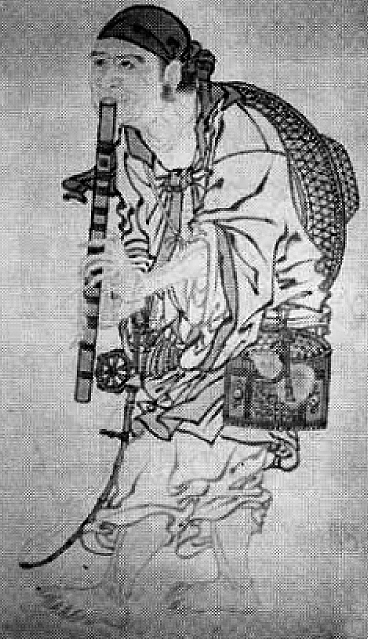
Another Picture of Rōan Playing a Flute discovered on the internet, uncommented. If you study and compare this picture closely with the two smaller ones above it you will soon realize that they are actually quite different! How can this be? Which of them is the original - which is a copy? Are they both falsifications? If this were indeed a genuine painting, more than 500 years old, it would have been created sometime between 1467, when the renowned painter monk Kenkō Shōkei, 賢江祥啓, was appointed clerksman/calligrapher at the Kenchō Zen Temple in Kamakura, and 1477, when the shakuhachi hermit Rōan supposedly added his short anecdote, his Chinese style 4-line 7-syllable poem, and the place and date, at the top of this quite mysterious hanging scroll. It has so far been impossible to locate a proper high resolution picture of the painting which includes the written text. Acc. to an internet web page (see link below) the hanging scroll is reproduced in the Nihon-ga taisei, 日本画大成, "A Compilation of Japanese Painting", 1931, Vol. 3, Plate 66. Fortunately, the shakuhachi scholar Ueno Katami appears to have had access to the original painting (or a good reproduction) and he has presented the complete text in his book Shakuhachi no rekishi, "History of the Shakuhachi", published in 2002 (revised and enlarged edition, first publ. in 1983), on page 153. Whether this painting attributed to Shōkei is actually "a fabrication", or not, let us appreciate the story and its sincere message for all it is worth, anyway: 余、東奥行脚の砌、相州巨福路, 建長禅寺宝珠庵に入り沓憇す。 庵主祥啓書記、吾が躰、甚だ異なるを相て、 以って 紙上に写し、而して予に給す。 依って年来演じる所を執って云う。 "While I [Rōan] was performing a pilgrimage along the Kobuku Road in Sōshū [Sagami, mod. Kanagawa Pref.] I entered the Hōju Hermitage at the Kenchō Zen Temple in [Kamakura] and rested my feet. The clerksman there, Shōkei the Hermit, noticed my very strange appearance, then rendered [my portrait] on paper and, eventually, bestowed it on me. For this reason, I said that I would form an attachment, committing myself to [come and] play [the shakuhachi] at that place for years to come." 竜頭切断兮以来 尺八寸中通古今 吹出無常心一曲 三千里外絶知音 "When Dualism is cut off, the shakuhachi dissolves the distinction between Past and Present. That one unique Sound of Everlasting Impermanence brings even the Purest of Wisdom [Skt.: Jnana] to an end, without limit." 時に文明丁酉 秋 宇治の旧蘆に於いて 朗庵叟書 "The 9th year of Bunmei [1477] - Autumn - Written among the old reeds of Uji by Rōan the Elder." Trsl. by Torsten Olafsson, 2010 & 2013. Source: Ueno, 2002, pp. 152-153. A rather poor version of the painting can be found here: www.um.u-tokyo.ac.jp/publish_db/1994collection1/tenji_kaiga_48.html www1.cncm.ne.jp/~seifu/rouanzu.htm & The poem is quite similar to poems preserved in various versions of the kyōgen play 'Rakuami'. 1494: 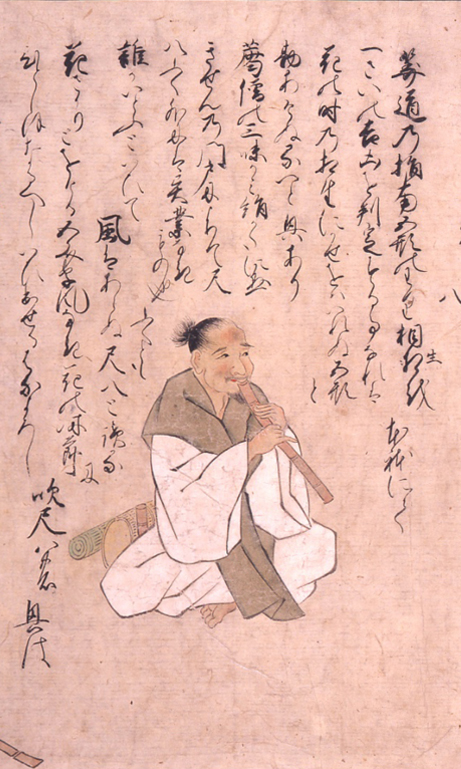
'Komosō' "mat monk" in 'Sanjūni-ban shokunin uta-awase emaki' Date of original: 1494. Kōsetsu-bon edition, detail. Suntory Museum of Art, Tokyo. Source: Wikipedia, Japan 1501: 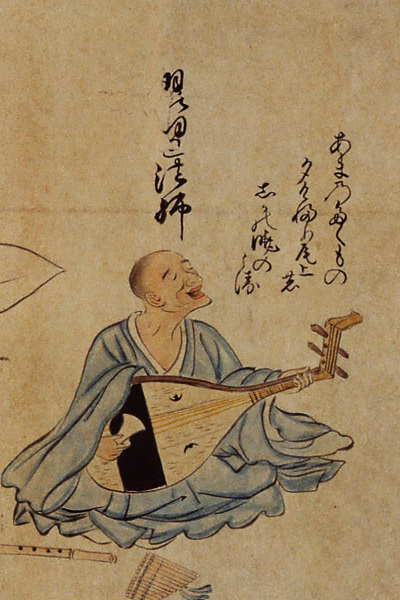
Biwa-hōshi with a short single-noded shakuhachi and a panflute by his side in 'Shichijūichi-ban shokunin utaawase emaki' Date of original: 1501. Tōkyō National Museum 1512: TAIGENSHŌ - by Toyohara Sumiaki (1450-1524) 體源抄 / 体源抄 楽人 - GAKUNIN 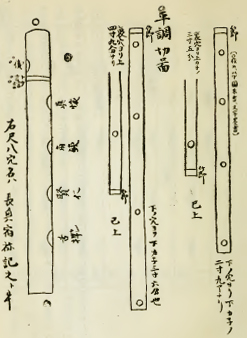
Single-node 'shakuhachi' pictures in the Taigenshō, 1512, Maki 5 The entire 1933 edition of the Taigenshō may be downloaded from this location: www.archive.org - Cheng Yu Tung East Asian Library, University of Toronto 1521-1532: 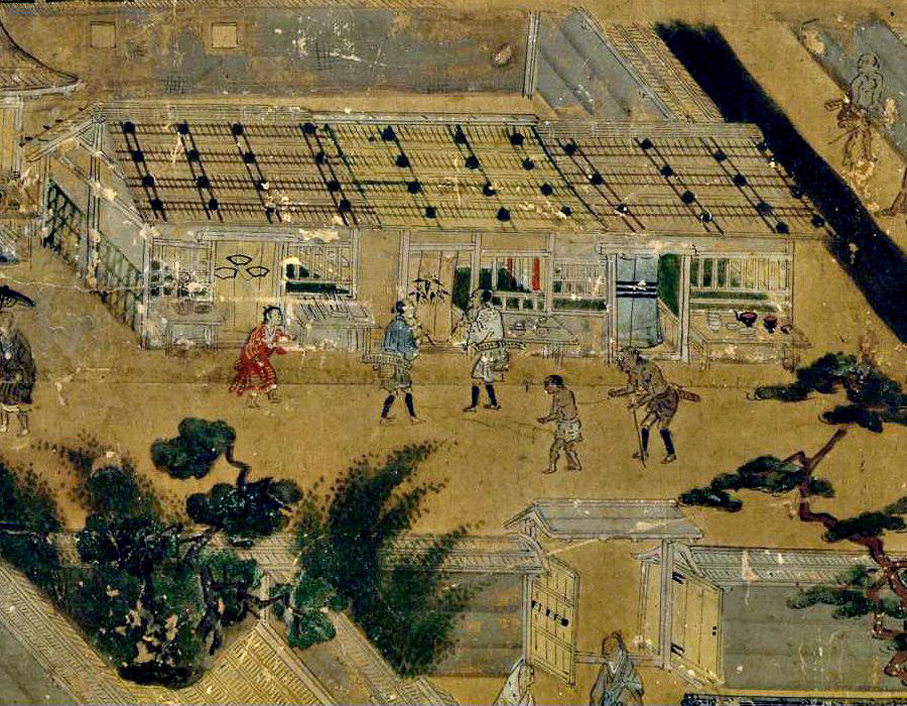 Two 'komosō' playing vertical flutes in a Kyōto street Detail of the folding screen 'Raku-chū raku-gai zu byōbu', "Pictures from In and Around the Capital", Machida-bon edition. Dated to between 1521 and 1532. 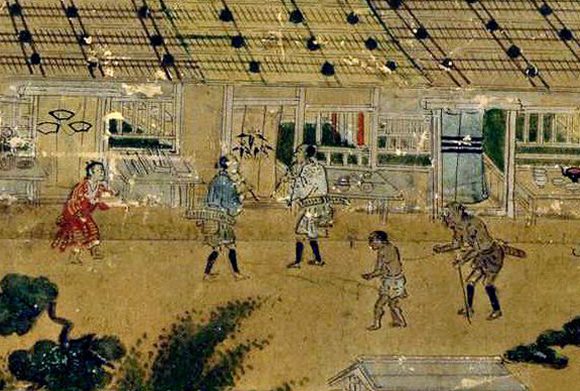
Close-up detail of the folding screen 'Raku-chū raku-gai zu byōbu', "Pictures from In and Around the Capital", Machida-bon edition. The National Museum of Japanese History, Sakura City, Chiba Prefecture For further information, see Gunnar Jinmei Linder, 2012, pp. 205-207. 1543, September 23 (W. calendar): A Portuguese merchant ship shipwrecks on a beach of the island Tanegashima south of Kyūshū, Japan. That is the first recorded visit of European Christians in Japan. 1549: The Spanish Jesuit missionary Francis Xavier lands in Kagoshima and begins movement to spread Christian teaching in Japan. 
Japanese portrait of Francis Xavier (1506-1552) Kōbe City Museum, Kōbe, Japan c. 1550 to 1628 or c. 1640?: ERA of the FUKE-KOMOSŌ普化薦僧
c. 1550-1560:
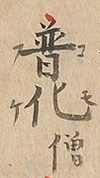

Details from the 'Ryūmon bunko no Setsuyōshū' Library of Nara Women's University - precise date unclear When, approximately, did the komosō of Medieval Japan adopt Fuke Zenji as their idol of shakuhachi asceticism? A few late Muromachi Period versions of the popular dictionary Setsuyōshū", "Economical Collection" or "Collection [of Words] for Everyday Use", do actually present noteworthy evidence in that respect: 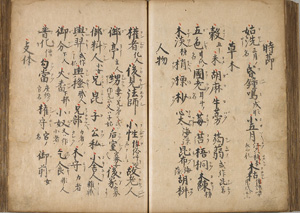
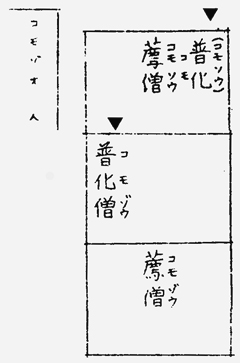
Right: Readings for the kanji 'Komo-sō' and 'Fu-ke(-sō)' in three different early versions of the 'Setsuyōshū' - second half of the 16th century 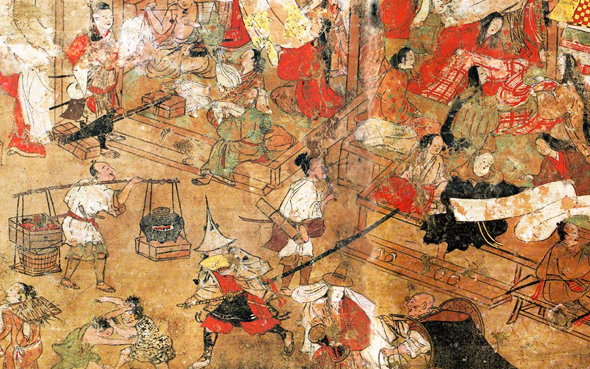
'Komosō' playing a short 'shakuhachi' ('hitoyogiri'?) in a street (center) Detail of section 4 of the folding screen 'Tsukinami fūzoku-zu byōbu' "Screen with Genre Scenes of the Twelve Months" Anonymous, late Muromachi Period (2nd half of 16th century). Tokyo National Museum 
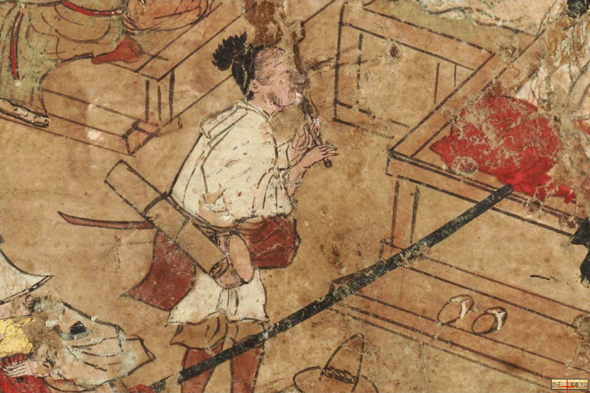
Do we actually see the 'komosō' above wearing a long sword, possibly made of wood (?), the tip of which is protruding from his left side, appearing just beneath the bed roll that he is carrying on his back? Link to an online, inter-active website presenting the complete screen: Tokyo National Museum - E-Museum online 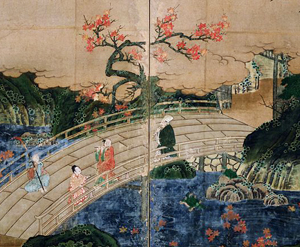
Possibly an tinerant monk (?) obviously playing a short vertical flute on a bridge Detail of the folding screen 'Takao kanpu-zu byōbu' By Kano Hideyori, act. 1565-1576. Tokyo National Museum 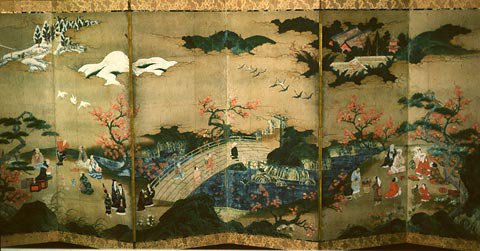
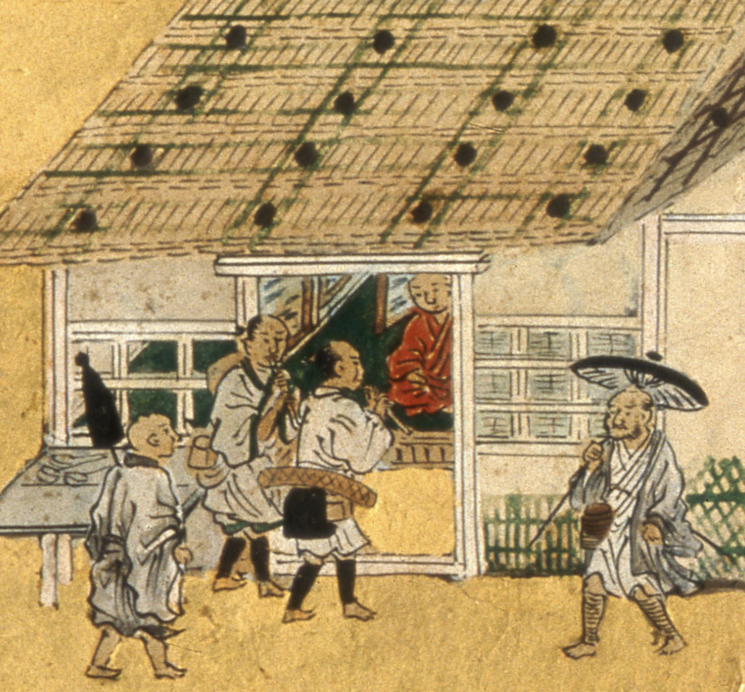
'Komosō' playing a vertical flute in a Kyōto street Detail of the folding screen 'Raku-chū raku-gai zu byōbu', "Pictures from In and Around the Capital", Uesugi-bon edition. Commissioned by Oda Nobunaga. The Yonezawa City Uesugi Museum, Yamagata Prefecture 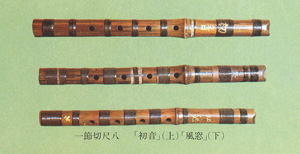
Old Edo Period (1603-1867) hitoyogiri shakuhachi. Makers unknown. In: Kikan Hōgaku 5, 1975. 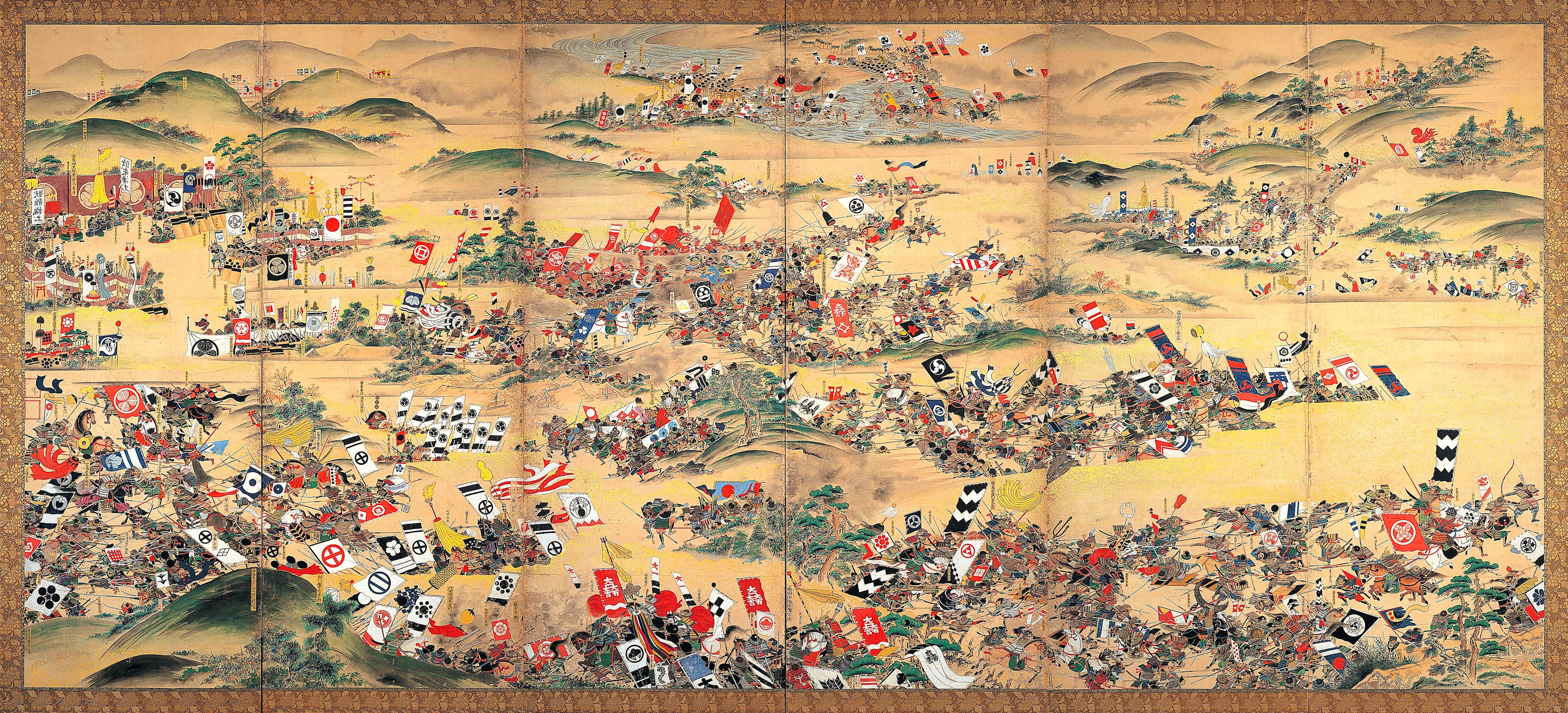
Source: WikiMedia 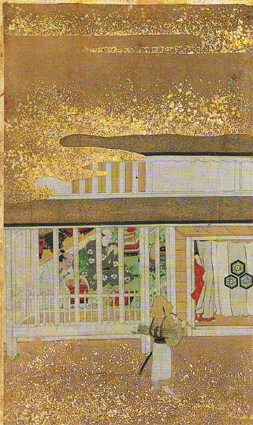
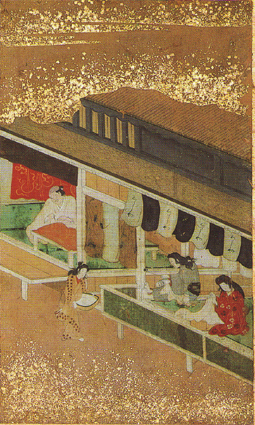
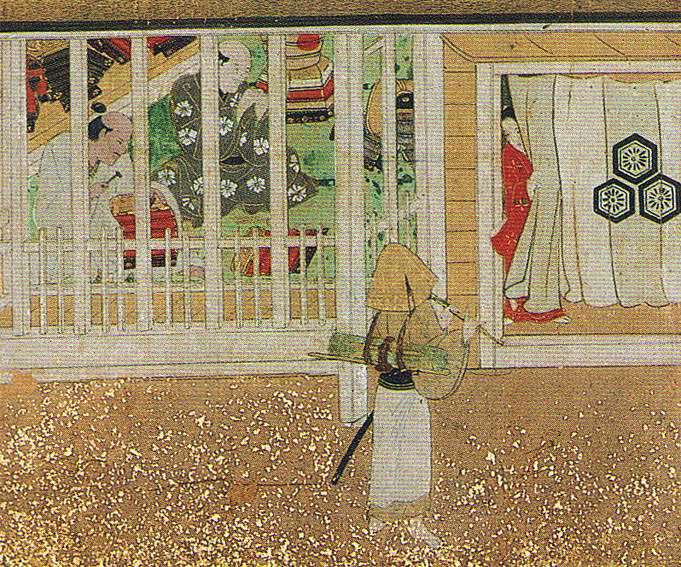
Yet not fully identified, so far undated, very early 17th century 'komosō' picture. Apparently part of a rather typical Azuchi-Momoyama Period gold-leaf decorated folding screen with everyday scenes, quite certainly dating from the early 1600s. 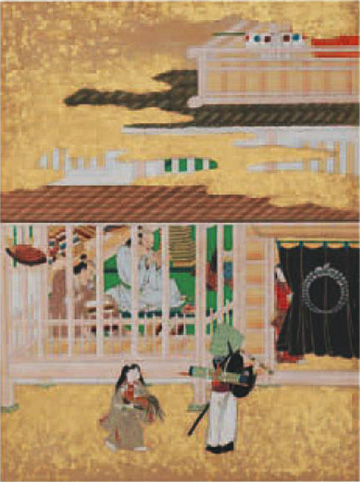
Very similar in theme and execution as the picture above, this is one of 12 illustrations on a folding screen dated to 1735 and titled 'Shokunin zukushi-e byōbu', 職人尽絵屏風, "Pictures of People of Various Occupations in Their Workshops". One would not term it "a copy", however, but rather an anachronism, as the shown mat-carrying 'komosō' type of mendicant flute-player had been replaced by the 'Komusō' many decades before 1735. The art historian Kazuko Kameda-Madar has described the screen in this article (link) at www.academia.edu: "Pictures of People of Various Occupations in Their Workshops" 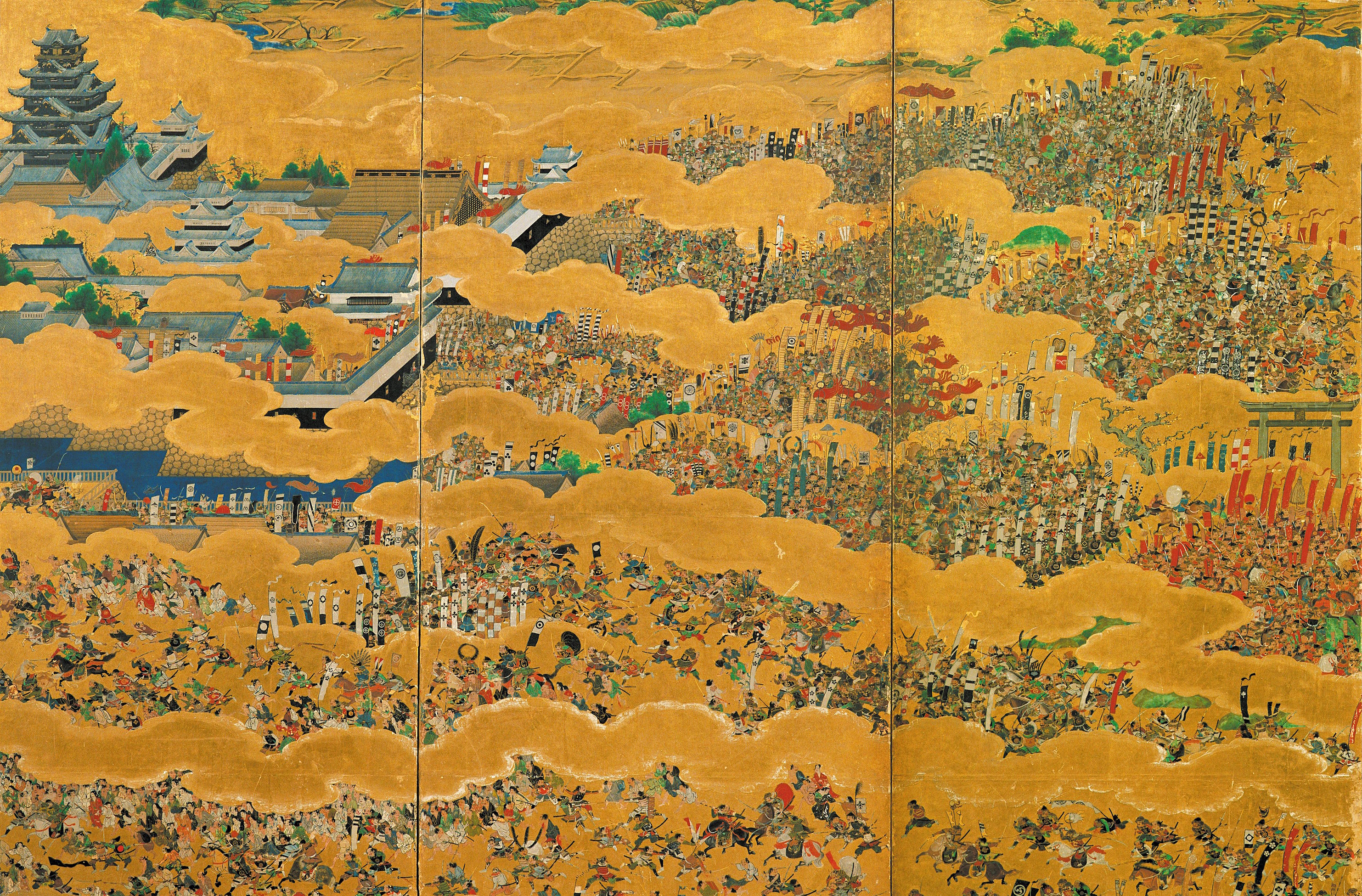
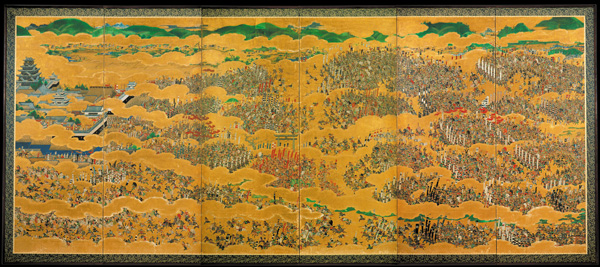
Source: WikiMedia 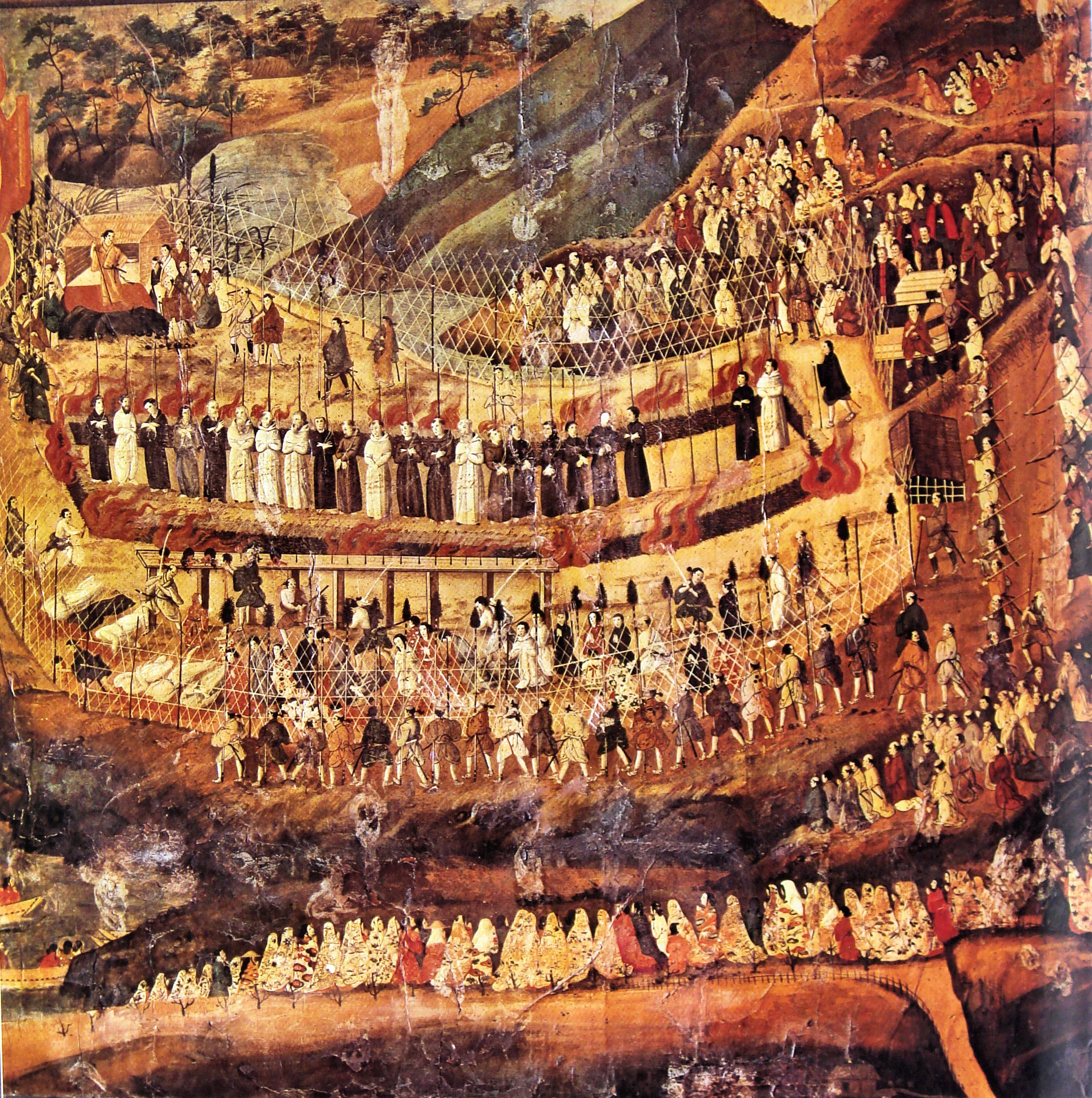
"The Great Genna Martyrdom in Nagasaki" Painting by unnamed Japanese artist. 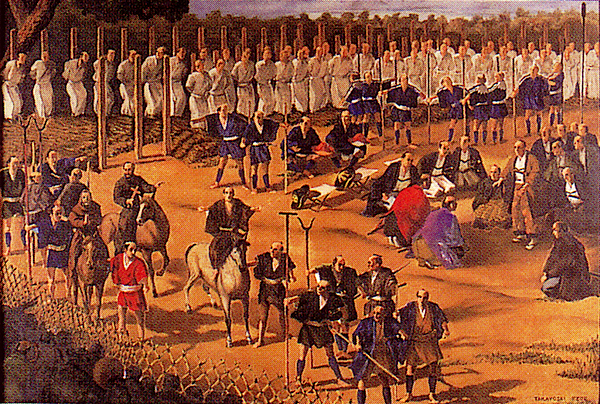
"The Great Martyrdom in Edo" Painting by unnamed Japanese artist. 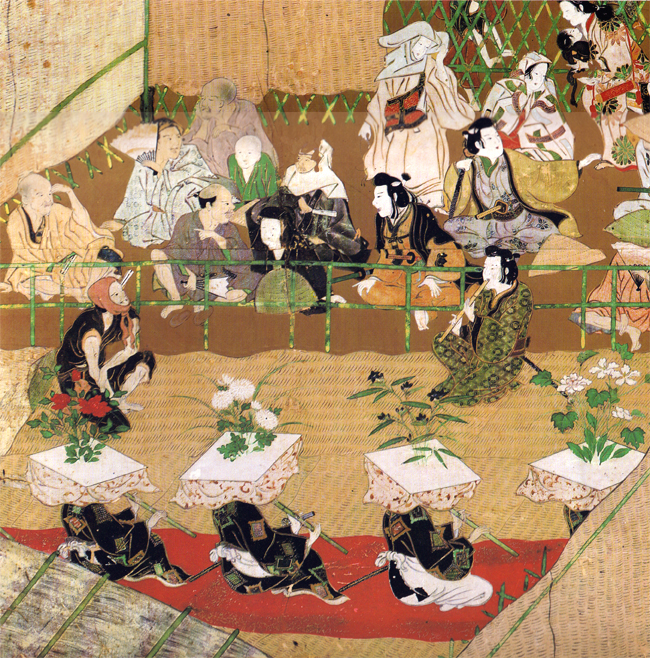
The Shijō shirakawa yūraku-zu folding screen: Female & male shakuhachi ('dōshō?') players and one 'hitoyogiri' player performing Kan'ei Period, 1624-44. Creator unknown Seikaidō Bunko Art Museum, Tōkyō 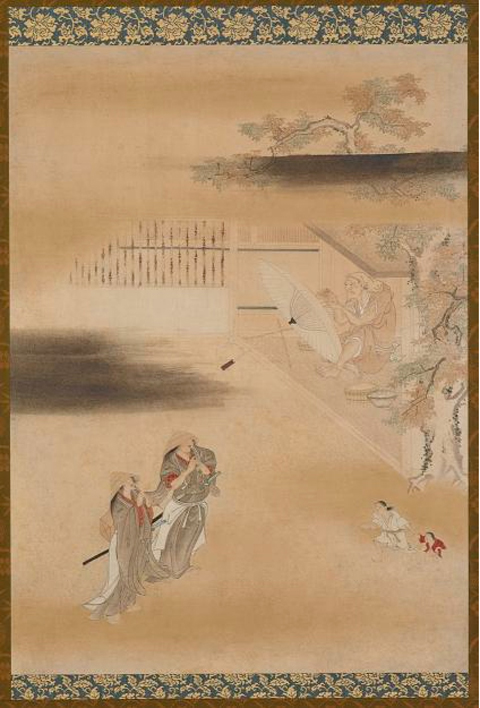
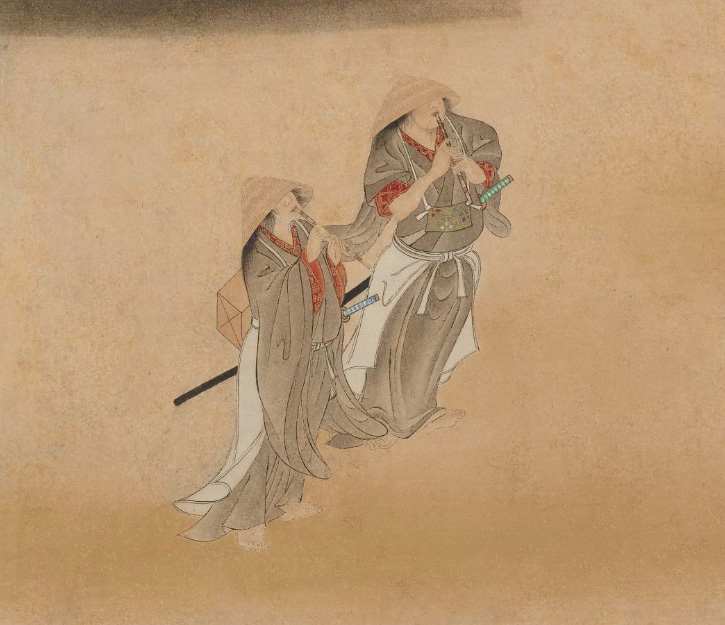
Iwasa Matabei's painting of Two Komosō & An Umbrella Maker, detail. Now in the possession of the Smithsonian/Freer Gallery of Art, Washington D.C. Dated no later than 1630, according to Japanese art historians c/o the Nezu Museum in Tokyo. 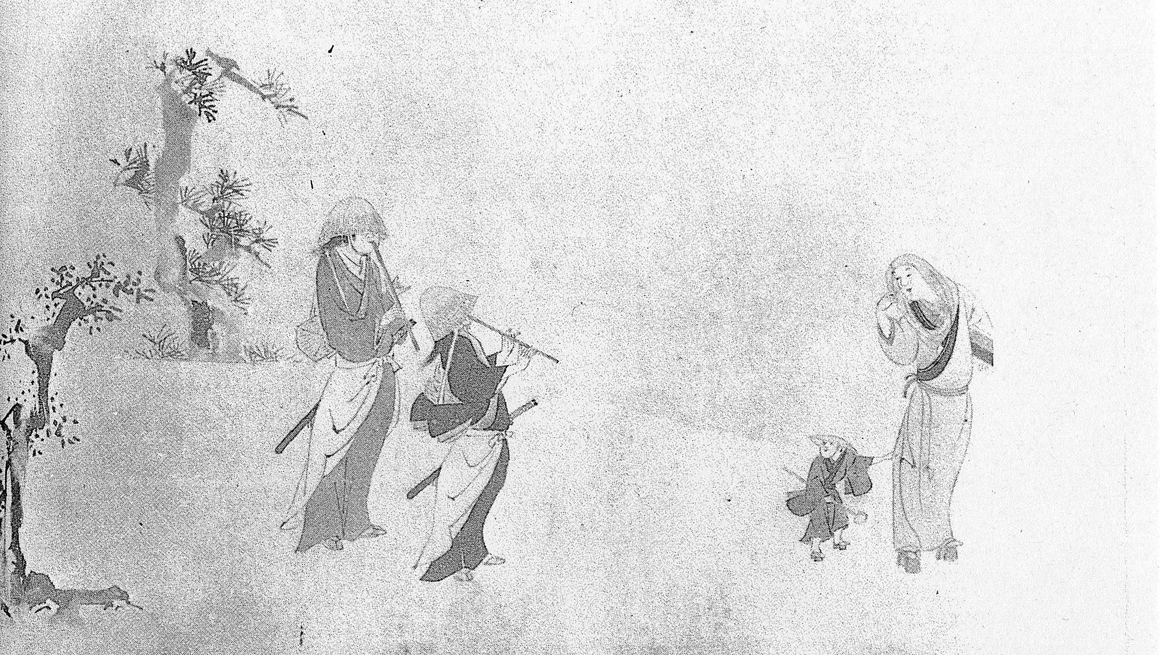
Illustration of two komosō with swords in the picture scroll 'Shokunin tsukushi zu-maki', apparently by Iwasa Katsumochi Matabei, 1578-1650. Idemitsu Bijutsu-kan/Idemitsu Museum of Art, Tokyo, Chiyoda City. Presented online by Shakuhachi-Kataha, link to web page: https://note.com/kataha_comjo/n/nb964ee048e6c |
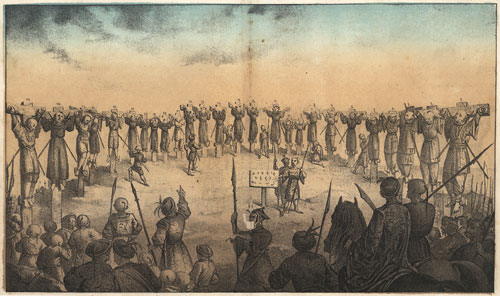
The 26 Christian Martyrs in Nagasaki. Painting by Eustaquio Maria de Nenclares, 1862.
On February 5, 1597, 26 Christians - missionaries and Japanese followers alike -
were crucified at Nishizaka in Nagasaki,
on the order of Toyotomi Hideyoshi, then the absolute ruler of Japan.
- the "Pseudo-Monks of the Non-dual & None-ness"
The practice of fumi-e, 踏み絵 - the forced trampling of Christian images - is introduced and kept in constant national execution and effect all through the year 1869.
The religious authorities of the Tokugawa shōgunate required suspected Christians to step on images of Jesus Christ or the Virgin Mary in order to prove that they were not members of that outlawed religion.
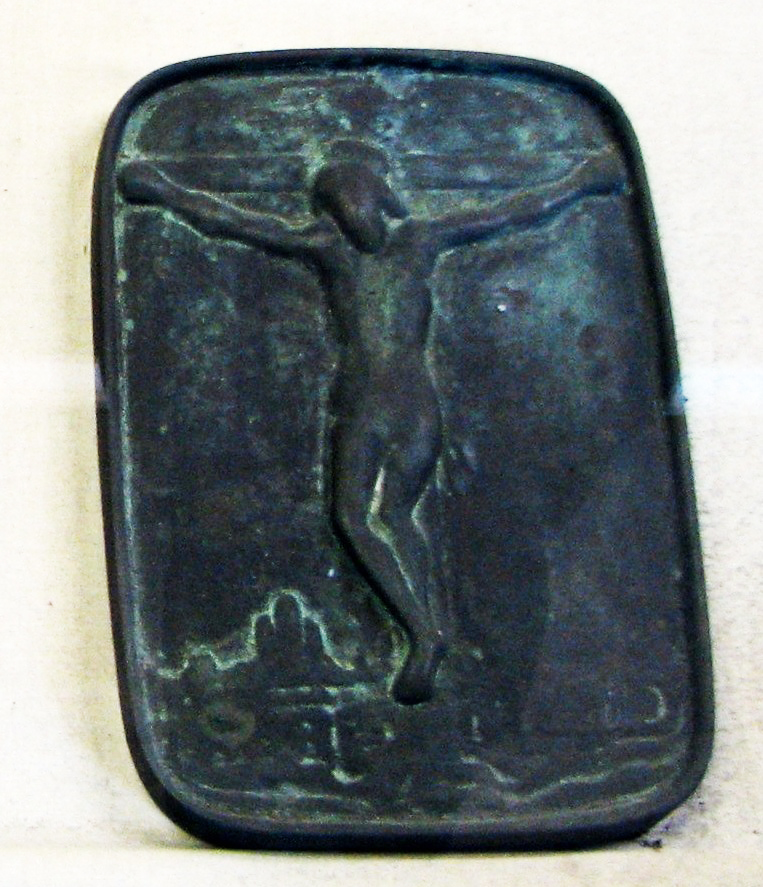
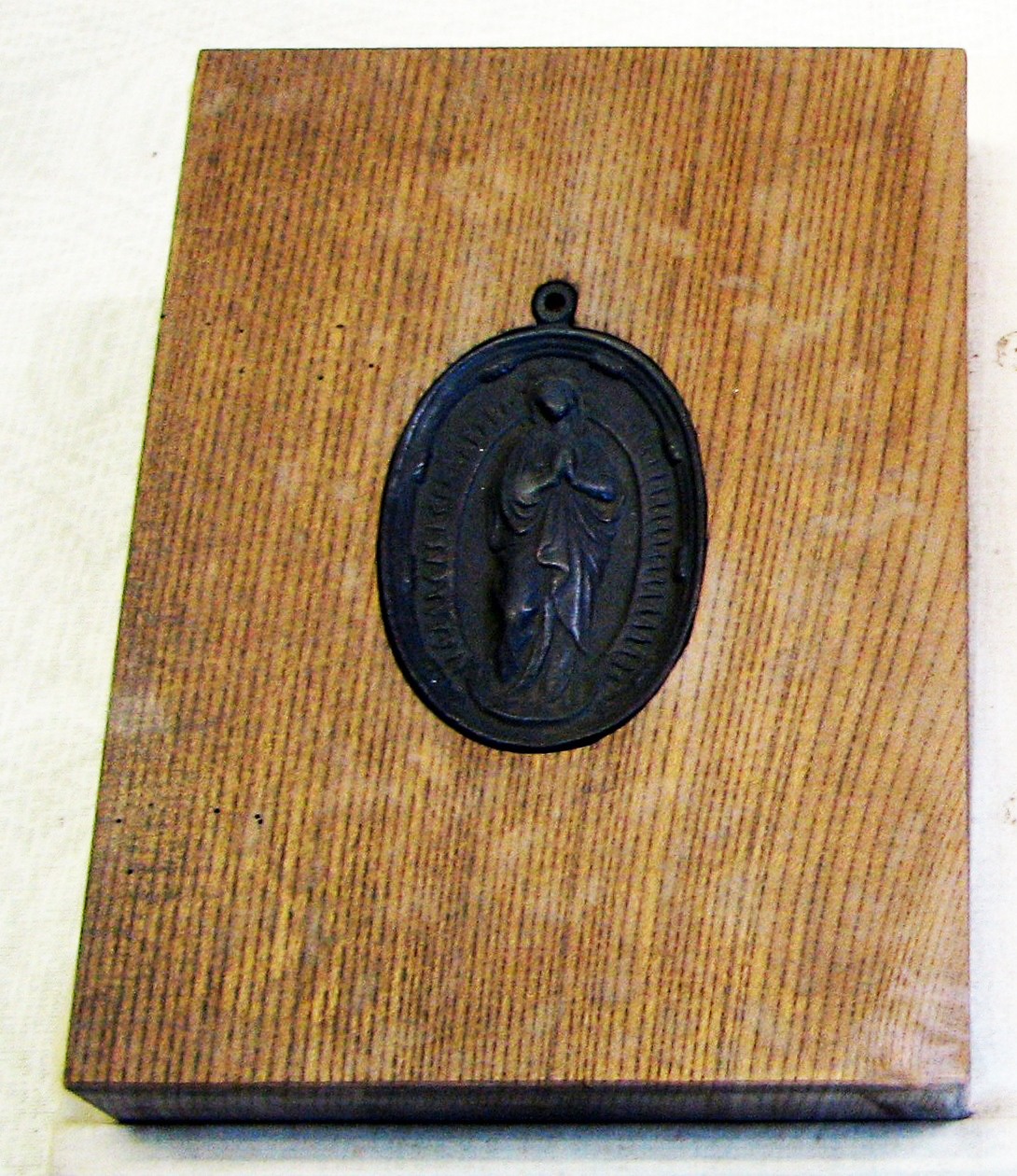
Fumi-e: Jesus Christ & the Virgin Mary tablets. No exact dates.
Source: https://ja.wikipedia.org/wiki/%E8%B8%8F%E3%81%BF%E7%B5%B5
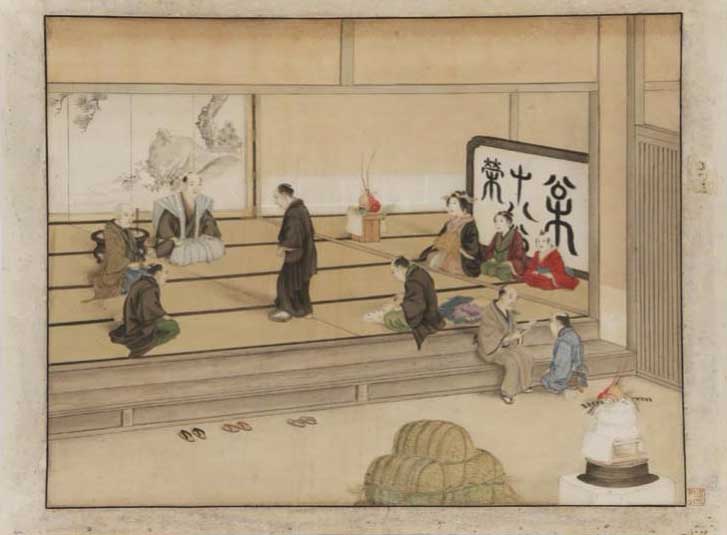
Painting of a 'fumi-e' inquisitional ceremony by Keiga Kawahara, created sometime during 1800-1829.
Source: National Library of the Netherlands. Link: geheugenvannederland.nl
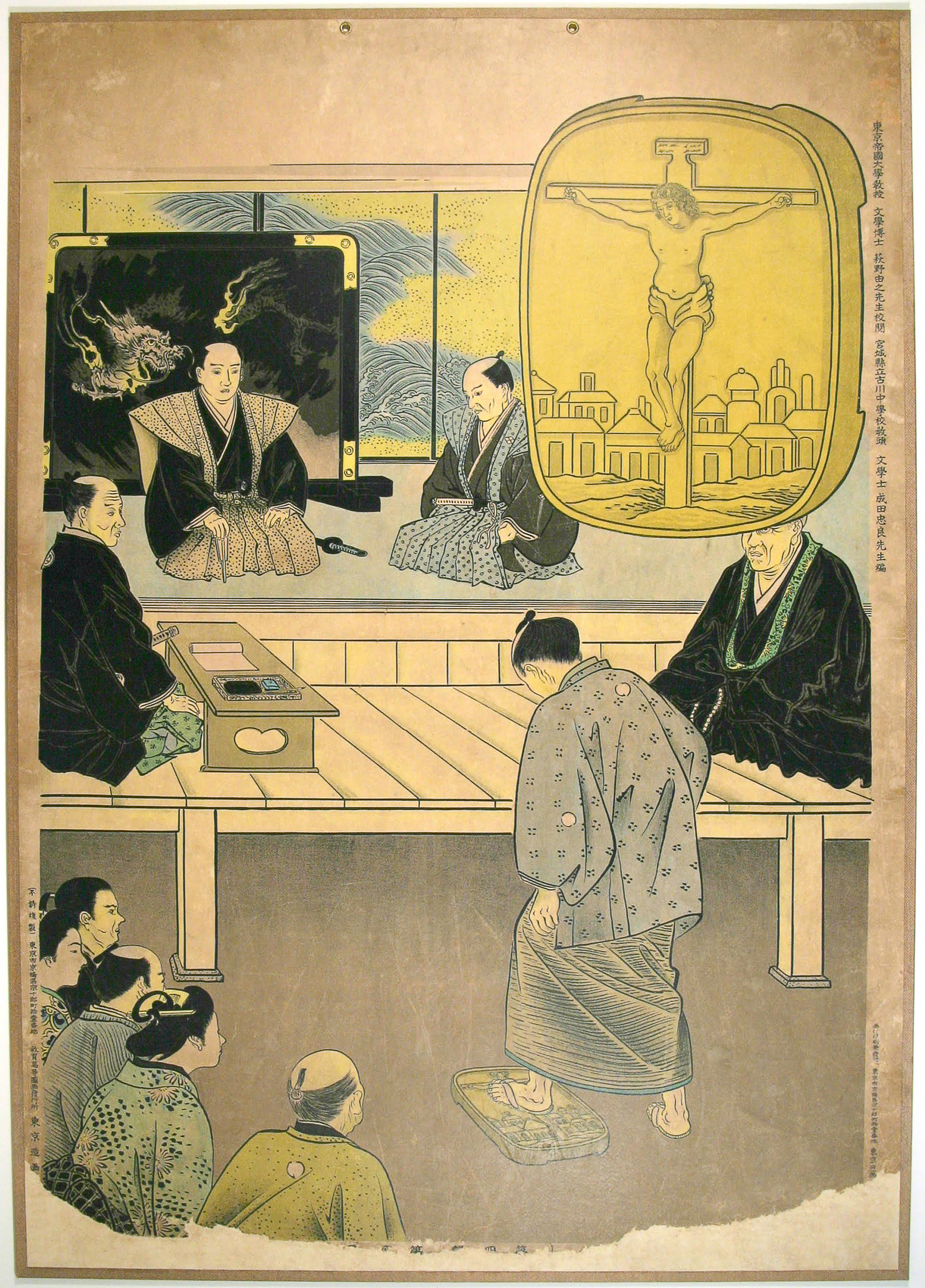
Date of picture acc. to Wikipedia: December 31, 1869.
Source: https://ja.wikipedia.org/wiki/%E8%B8%8F%E3%81%BF%E7%B5%B5
Mid-1600s?:
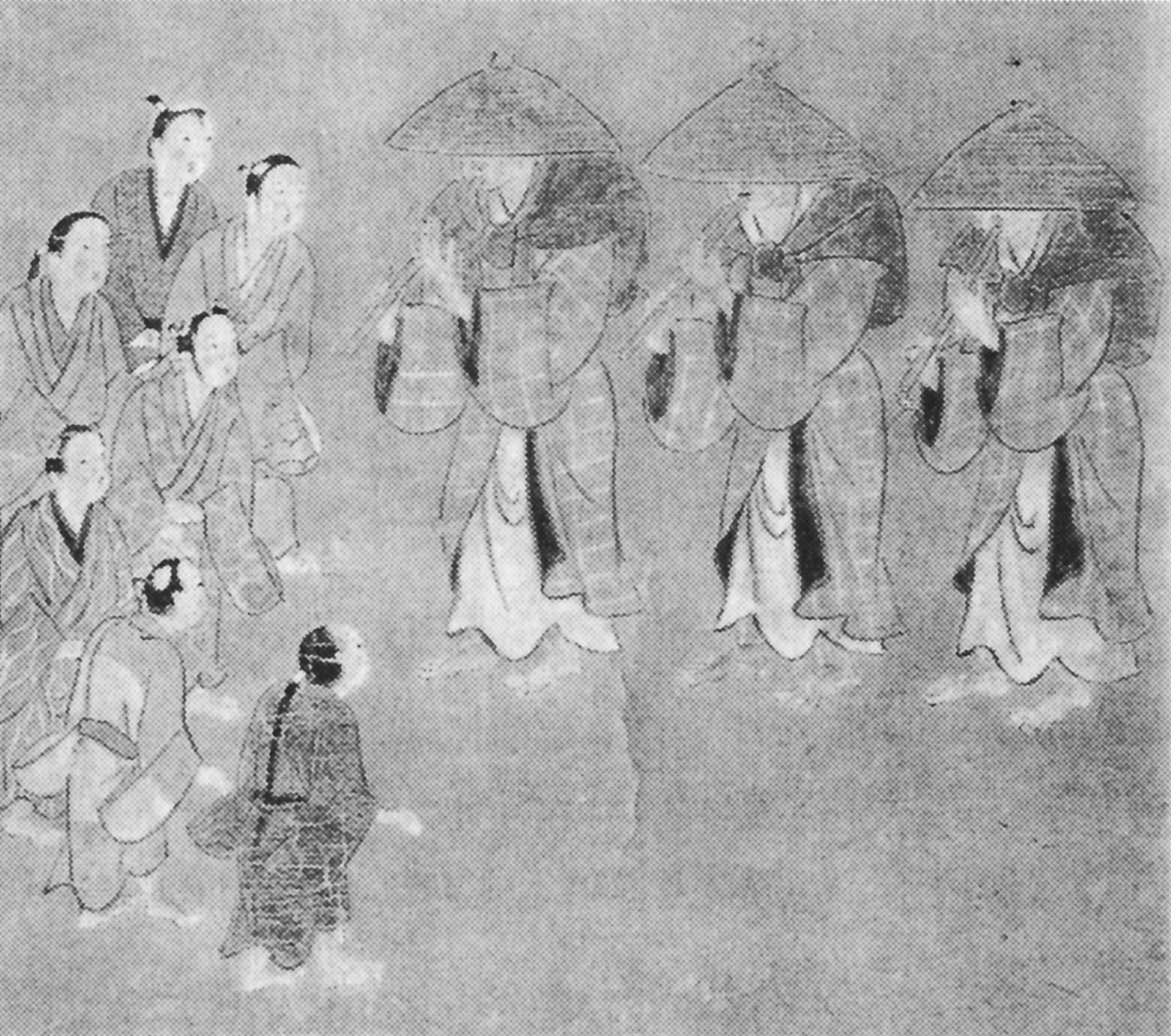
Painting of three early 'Komusō'?
Attributed to Iwasa Matabei, 1578-1650.
Possibly dating from the 1630s.
Owned by the Shingon Sect temple Tōya-san Fumon-ji Taishō-in near Matsudo City in NW. Chiba Pref. Source: Yamaguchi Masayoshi, 2005, p. 176.
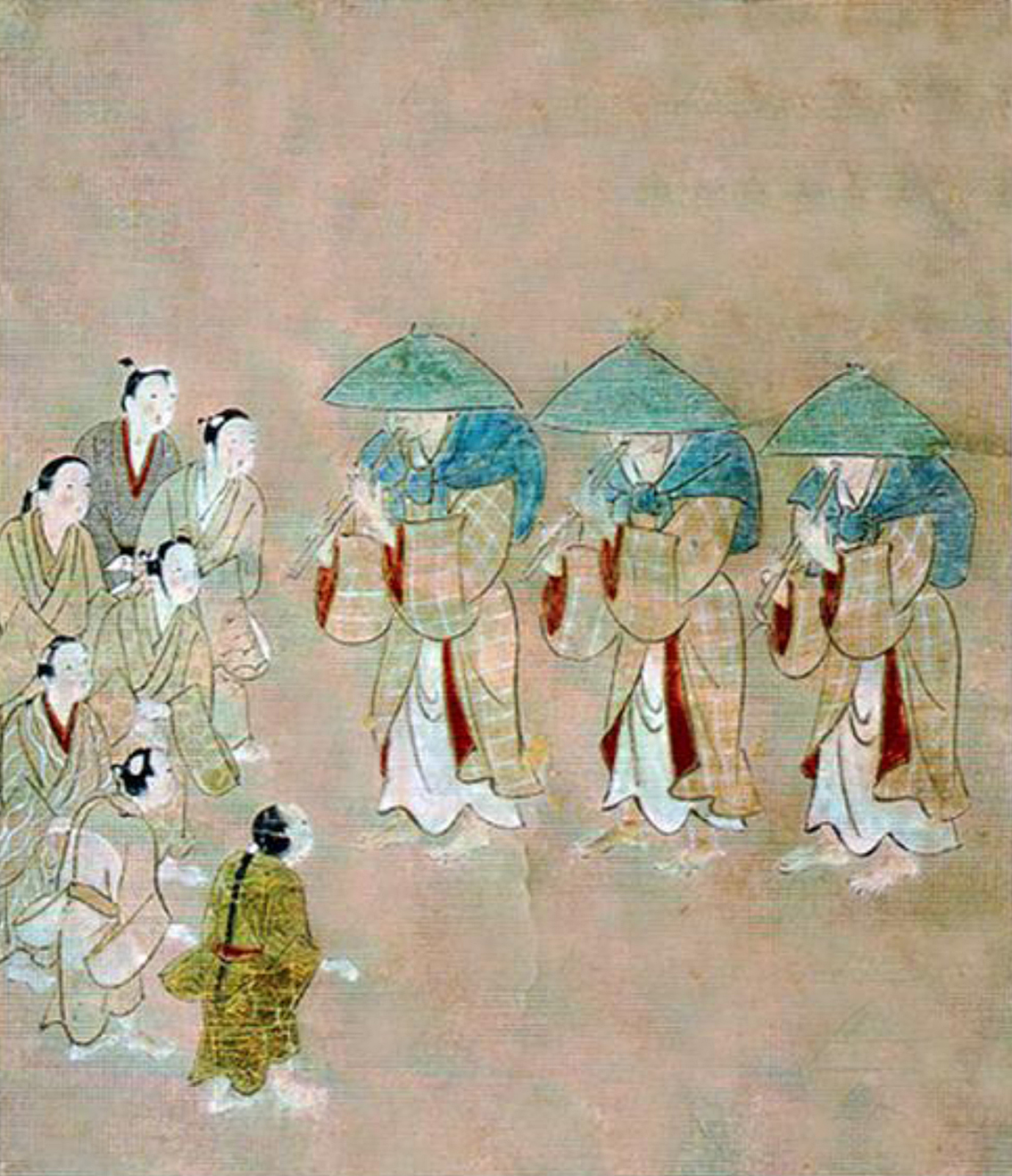
Painting of three early 'Komusō'?
Acc. to Kakizaki Shōhō, this picture should date from the Genroku Period, 1688-1704.
If that were so, Iwasa Matabei, 1578-1650, cannot be the artist.
Most probably 1630s-1640s:
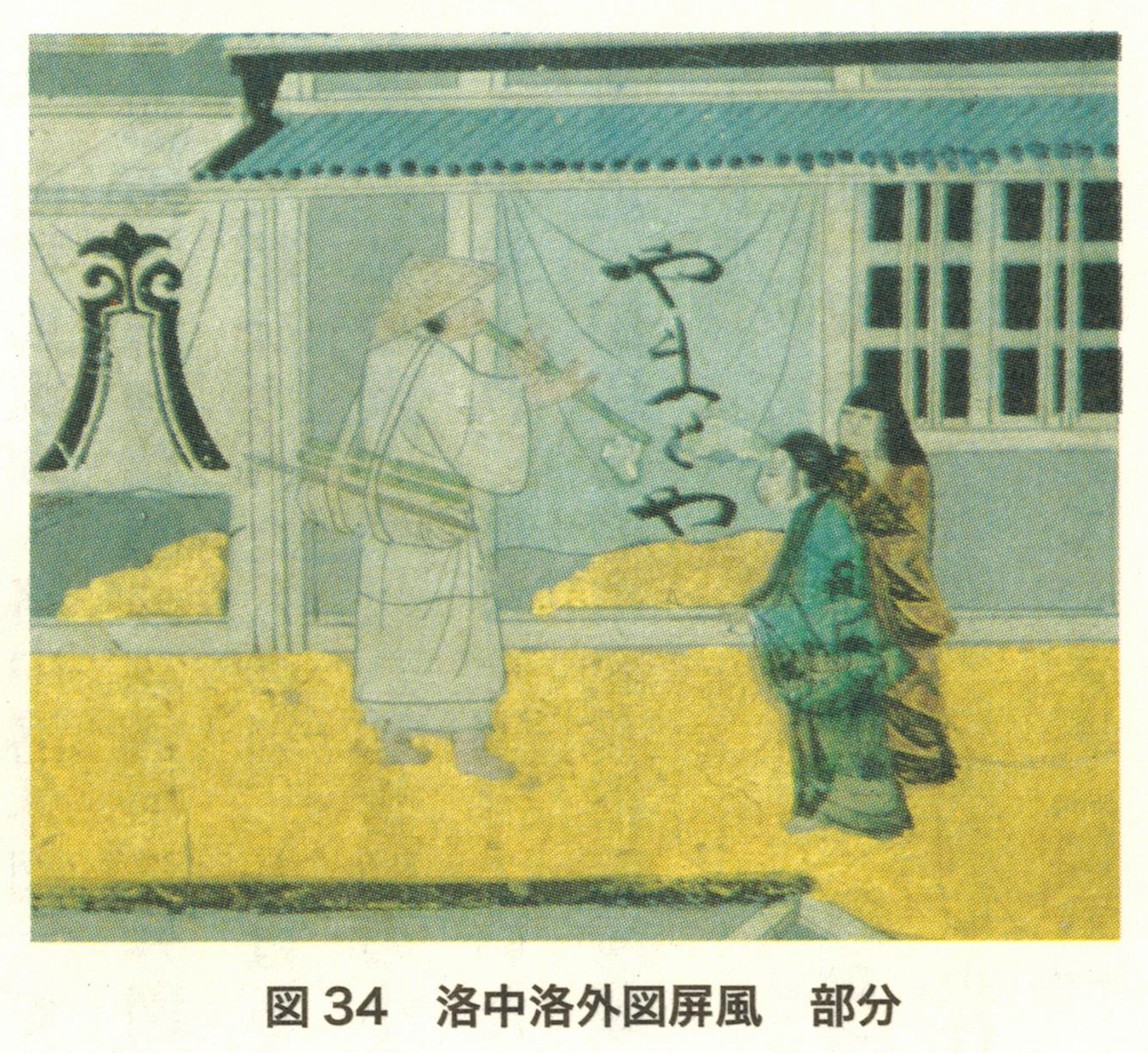
Picture of a late 'Komosō' or: an early 'Komusō'? in a Kyōto street.
Detail of a yet not fully recognized and identified version
of a 'Raku-chū raku-gai zu byōbu'.
Possibly dating from the 1630s.
Do note that the flute player is carrying a sleeping roll on his back,
with three extra long flutes on top of the roll,
like a 'Komosō' "beggar monk" - not like a 'Komusō', at all!
Source: Izumi Takeo, 2013, pp. 82-83.
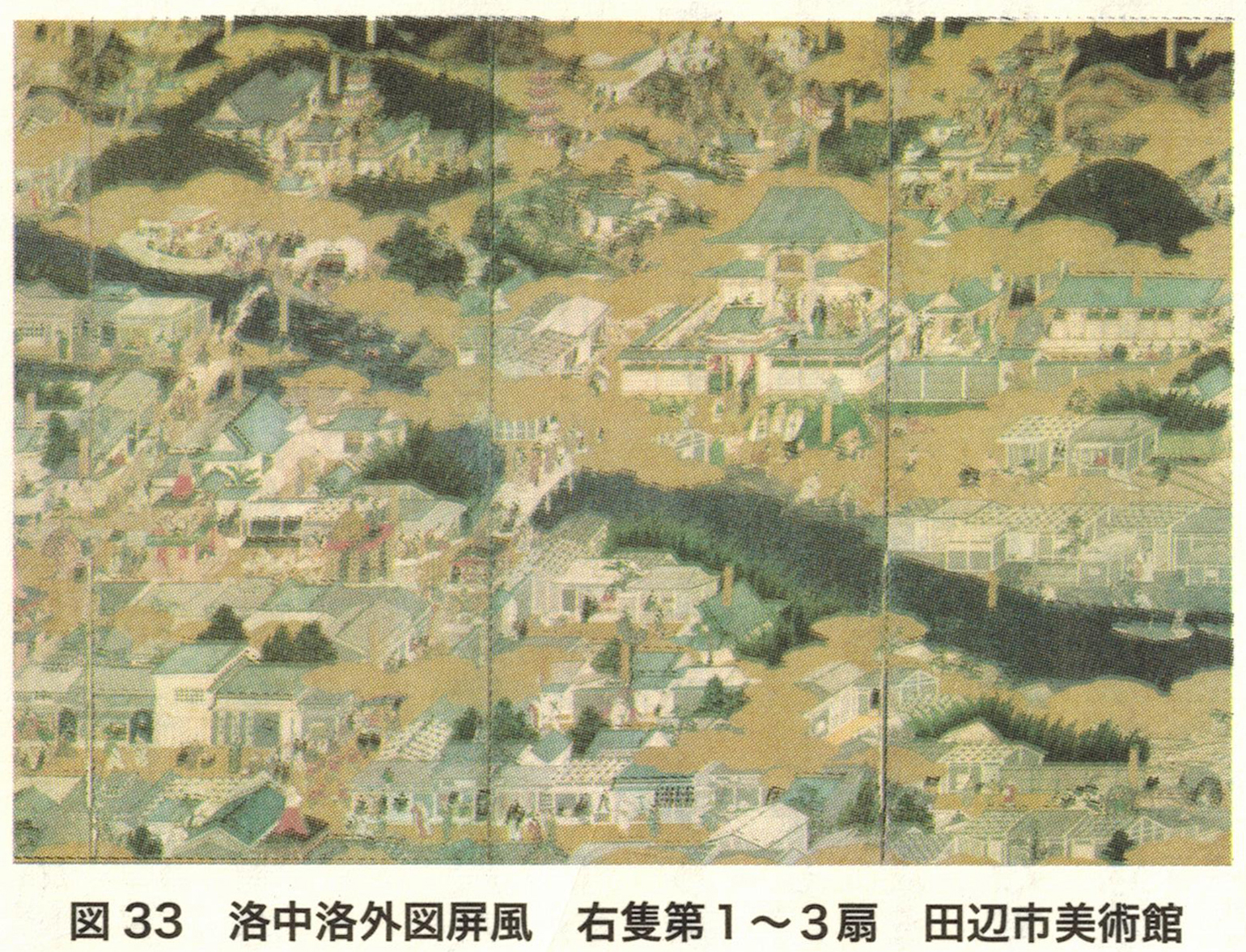
You find the detail in the very bottom of the screen,
right above the Japanese character, 'zu', 図.
The screen is a treasure of the Tanabe City Fine Arts Hall.
Source: Izumi Takeo, 2015, p. 81.
1630s?:

Illustration of a 'Komosō' mat monk beggar blowing a long flute, like a Chinese 'tung-hsiao', Japanese: 'dōshō'. No source documentation is otherwise presented on Dean Del Bene's weblog, see link just below:
Presented online by Dean Del Bene, link to web page, dated July 2, 2024/December 2, 2023:
http://myoanshakuhachi.blogspot.com/
Most probably 1630s-1640s:
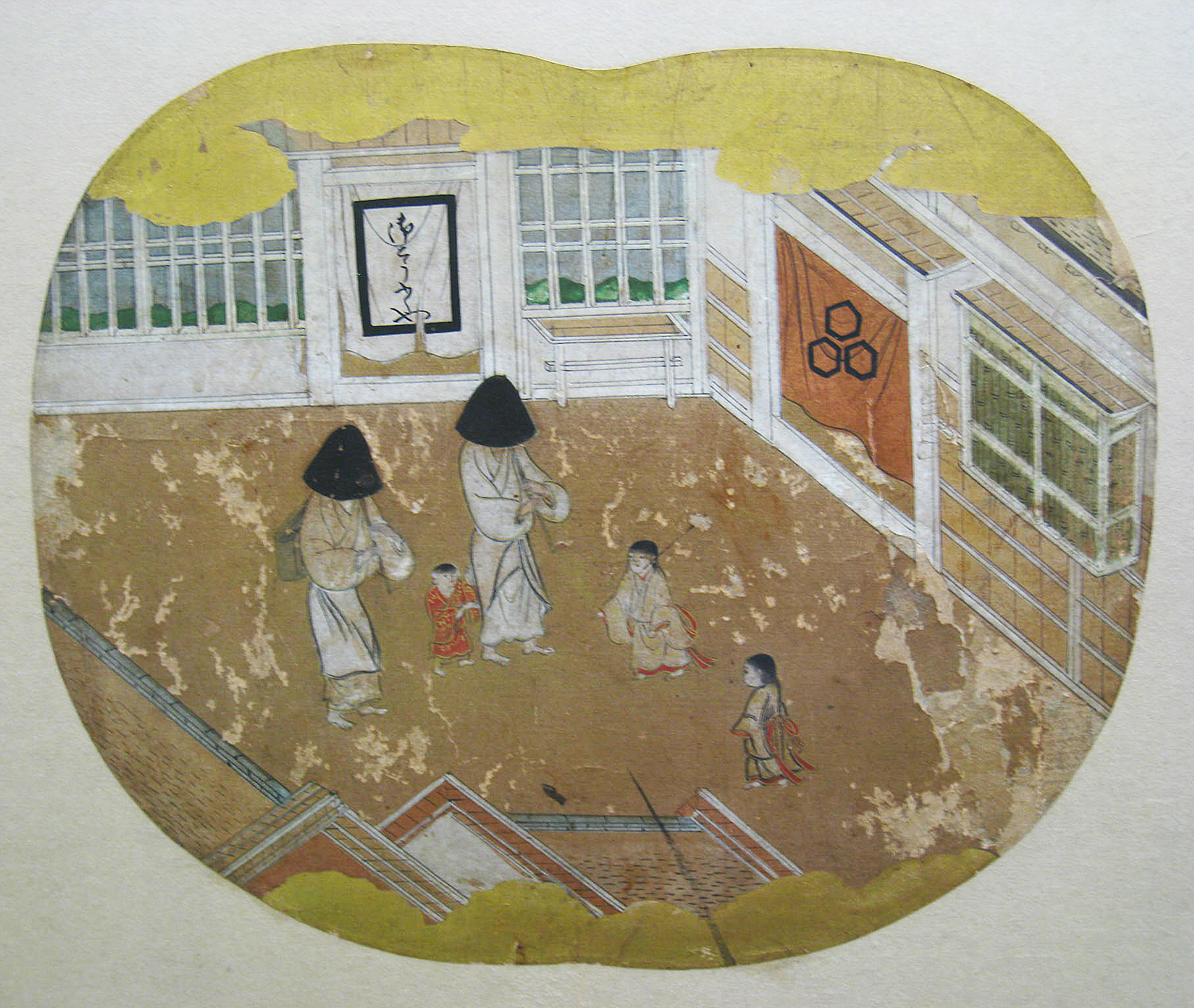
Yet not fully identified and dated early 17th century 'Komusō'? picture.
Possibly dating from the 1630s?
Exhibited at Matsudo City Museum, Matsudo-shi, NW Chiba Pref.
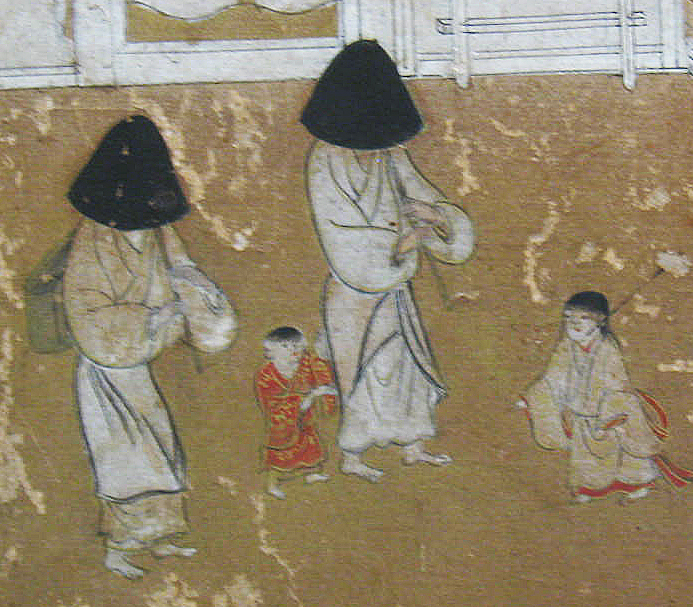
Detail
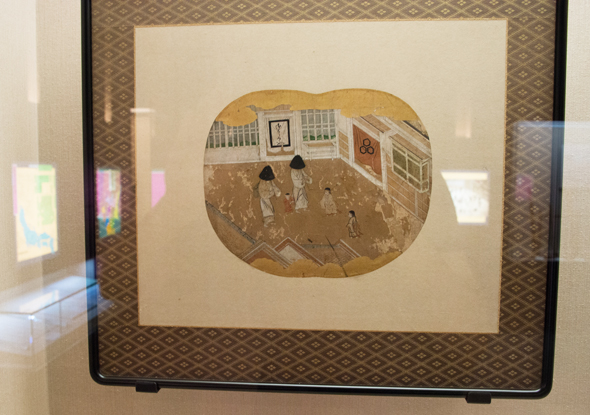
The above picture photographed at the Matsudo City Museum in Chiba
by Ronald Nelson, summer 2014.
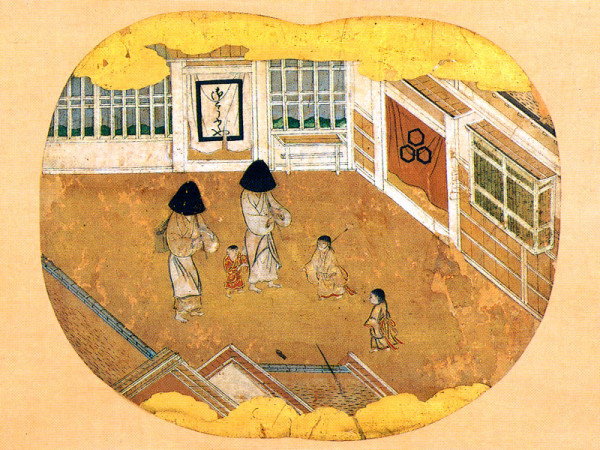
Acc. to Bandō Jirō's weblog, however: From a (yet obscure!) 17th century art work entitled
Jidai fūzokuga-fuku", 時代風俗画幅, "Scroll with Pictures of Customs of the Day".
Post card purchased by a companion of Bandō Jirō's at Matsudo City Museum in Autumn 2012
Link: Bandō Jirō's weblog
1637-38 - The SHIMABARA REBELLION near NAGASAKI on KYŪSHŪ
1637: Christian farmers, warriors, 'rōnin' (masterless samurai) and others revolt against the authorities on the Shimabara Peninsula in Kyūshū.
When the uprising was put down in 1638, tens of thousands had been killed.
All surviving rebels, numbering in the thousands, were decapitated.
Christianity was now strictly outlawed in Japan and informers were encouraged.
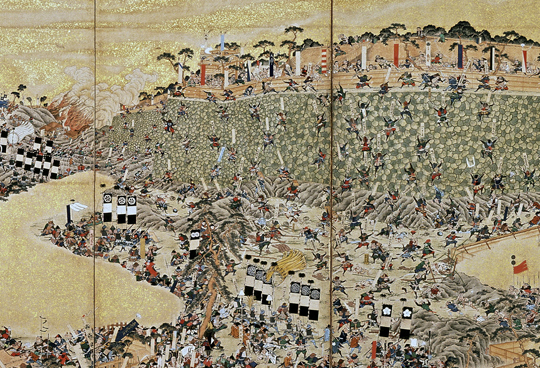
'Shimabara ran-zu byōbu'
"Folding screen depicting the rebellion at Shimabara".
Source: Wikipedia.
1640, 6th Month, 17th Day:
The 'SHŪMON ARATAME-YAKU', "The Office of Sect Inquisition" is Established
See also:
Historical Shakuhachi Images 2
- from just before 1640 till the Present:
A Pictorial Chronology of Known Fine Historical
Illustrations of so called 'Shakuhachi' Flutes,
Its Many Players Throughout The Times,
with Additional Shakuhachi History Related Images
| To the front page | To the top |